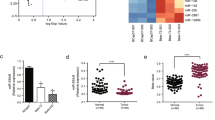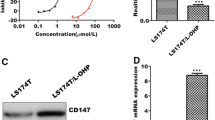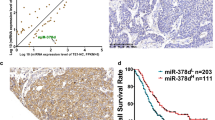Abstract
Chemoresistance is a key cause of treatment failure in colon cancer. MiR-22 is a tumor-suppressing microRNA. To explore whether miR-22 is an important player in the development of chemoresistance in colon cancer, we overexpressed miR-22 and subsequently tested its role in cell proliferation, apoptosis, survival, and associated signaling in p53-mutated HT-29 and HCT-15 cells, and p53 wild-type HCT-116 cells. We further investigated the role of miR-22 on cytotoxicity of paclitaxel in both the p53-mutated and p53 wild-type colon cancer cells. Results showed that HT-29 and HCT-15 cells were resistant to paclitaxel-induced cytotoxicity, which normally inhibits cell proliferation and survival, and induces apoptosis. Conversely, HCT-116 was relatively sensitive to the cytotoxicity of paclitaxel. Overexpression of miR-22 significantly decreased cell proliferation and survival, and induced cell apoptosis in the p53-mutated colon cancer cells, but played no role in the p53 wild-type cells. Importantly, miR-22 overexpression enhanced the cytotoxic role of paclitaxel in p53-mutated HT-29 and HCT-15 cells, but not in p53 wild-type HCT-116 cell. We further demonstrated that the tumor-suppressive role of miR-22 in p53-mutated colon cancer cells was mediated by upregulating PTEN expression, which negatively regulated Akt phosphorylation at Ser473 and MTDH expression, and subsequently increased Bax and active caspase-3 levels. Our study is the first to identify the tumor-suppressive role of miR-22 and its associated signaling in the p53-mutated colon cancer cells and highlighted the chemosensitive role of miR-22.




Similar content being viewed by others
References
“Cancer”. National Cancer Institute. (2009) http://www.cancer.gov/cancertopics
Xu AG, Yu ZJ, Jiang B, Wang XY, Zhong XH, Liu JH, Lou QY, Gan AH (2010) Colorectal cancer in Guangdong Province of China: a demographic and anatomic survey. World J Gastroenterol 16:960–965
Ades S (2009) Adjuvant chemotherapy for colon cancer in the elderly: moving from evidence to practice. Oncology 23:162–167
Kelland L (2007) The resurgence of platinum-based cancer chemotherapy. Nat Rev Cancer 7:573–584
Dai A, Huang Y, Sadee W (2004) Growth factor signaling and resistance to cancer chemotherapy. Curr Top Med Chem 4:1347–1356
De Ligio JT, Velkova A, Zorio DA, Monteiro AN (2009) Can the status of the breast and ovarian cancer susceptibility gene 1 product (BRCA1) predict response to taxane-based cancer therapy? Anticancer Agents Med Chem 9:543–549
Shitara K, Oze I, Mizota A, Kondo C, Nomura M, Yokota T, Takahari D, Ura T, Yuki S, Komatsu Y, Matsuo K, Muro K (2010) Randomized phase II study comparing dose escalated weekly paclitaxel vs. standard dose weekly paclitaxel for patients with previously treated advanced gastric cancer. Jpn J Clin Oncol [Epub ahead of print]
Hiro J, Inoue Y, Toiyama Y, Yoshiyama S, Tanaka K, Mohri Y, Miki C, Kusunoki M (2010) Possibility of paclitaxel as an alternative radiosensitizer to 5-fluorouracil for colon cancer. Oncol Rep 24:1029–1034
Skobeleva N, Menon S, Weber L, Golemis EA, Khazak V (2007) In vitro and in vivo synergy of MCP compounds with mitogen-activated protein kinase pathway- and microtubule-targeting inhibitors. Mol Cancer Ther 6:898–906
Haldar S, Jena N, Croce CM (1995) Inactivation of Bcl-2 by phosphorylation. Proc Natl Acad Sci USA 92:4507–4511
Djeu JY, Wei S (2009) Clusterin and chemoresistance. Adv Cancer Res 105:77–92
Argov M, Bod T, Batra S, Margalit R (2010) Novel steroid carbamates reverse multidrug-resistance in cancer therapy and show linkage among efficacy, loci of drug action and P-glycoprotein’s cellular localization. Eur J Pharm Sci 41:53–59
Valencia-Sanchez MA, Liu J, Hannon GJ, Parker R (2006) Control of translation and mRNA degradation by miRNAs and siRNAs. Genes Dev 20:515–524
Bagga S, Pasquinelli AE (2006) Identification and analysis of microRNAs. Genet Eng (NY) 27:1–20
Bar N, Dikstein R (2010) miR-22 forms a regulatory loop in PTEN/AKT pathway and modulates signaling kinetics. PLoS One 5:e10859
Xiong J, Du Q, Liang Z (2010) Tumor-suppressive microRNA-22 inhibits the transcription of E-box-containing c-Myc target genes by silencing c-Myc binding protein. Oncogene 29:4980–4988
Ting Y, Medina DJ, Strair RK, Schaar DG (2010) Differentiation-associated miR-22 represses Max expression and inhibits cell cycle progression. Biochem Biophys Res Commun 394:606–611
Mi J, Zhang X, Rabbani ZN, Liu Y, Su A, Vujaskovic Z, Kontos CD, Sullenger BA, Clary BM (2006) H1 RNA polymerase III promoter-driven expression of an RNA aptamer leads to high-level inhibition of intracellular protein activity. Nucleic Acids Res 34:3577–3584
Zhang X, Li Y, Huang Q, Wang H, Yan B, Dewhirst MW, Li CY (2003) Increased resistance of tumor cells to hyperthermia mediated by integrin-linked kinase. Clin Cancer Res 9:1155–1160
McEwan DG, Brunton VG, Baillie GS, Leslie NR, Houslay MD, Frame MC (2007) Chemoresistant KM12C colon cancer cells are addicted to low cyclic AMP levels in a phosphodiesterase 4-regulated compartment via effects on phosphoinositide 3-kinase. Cancer Res 67:5248–5257
McDonald GT, Sullivan R, Paré GC, Graham CH (2010) Inhibition of phosphatidylinositol 3-kinase promotes tumor cell resistance to chemotherapeutic agents via a mechanism involving delay in cell cycle progression. Exp Cell Res 316:3197–3206
Huang WC, Hung MC (2009) Induction of Akt activity by chemotherapy confers acquired resistance. J Formos Med Assoc 108:180–194
Li Z, Thiele CJ (2007) Targeting Akt to increase the sensitivity of neuroblastoma to chemotherapy: lessons learned from the brain-derived neurotrophic factor/TrkB signal transduction pathway. Expert Opin Ther Targets 11:1611–1621
Zhang X, Mi J, Wetsel WC, Davidson C, Xiong X, Chen Q, Ellinwood EH, Lee TH (2006) PI3 kinase is involved in cocaine behavioral sensitization and its reversal with brain area specificity. Biochem Biophys Res Commun 340:1144–1150
Sasabe E, Tatemoto Y, Li D, Yamamoto T, Osaki Y (2005) Mechanism of HIF-1alpha-dependent suppression of hypoxia-induced apoptosis in squamous cell carcinoma cells. Cancer Sci 96:394–402
Blanco-Aparicio C, Renner Q, Leal JF, Carnero A (2007) PTEN, more than the AKT pathway. Carcinogenesis 28:1379–1386
Yin Y, Shen WH (2008) PTEN a new guardian of the genome. Oncogene 27:5443–5453
Hu G, Wei Y, Kang Y (2009) The multifaceted role of MTDH/AEG-1 in cancer progression. Clin Cancer Res 15:5615–5620
Hu G, Chong RA, Yang Q, Wei Y, Blanco MA, Li F, Reiss M, Au JT, Haffty BG, Kang Y (2009) MTDH activation by 8q22 genomic gain promotes chemoresistance and metastasis of poor-prognosis breast cancer. Cancer Cell 15:9–20
Emdad L, Sarkar D, Su ZZ, Randolph A, Boukerche H, Valerie K, Fisher PB (2006) Activation of the nuclear factor kappaB pathway by astrocyte elevated gene-1: implications for tumor progression and metastasis. Cancer Res 66:1509–1516
Lee SG, Su ZZ, Emdad L, Sarkar D, Fisher PB (2006) Astrocyte elevated gene-1 (AEG-1) is a target gene of oncogenic Ha-ras requiring phosphatidylinositol 3-kinase and c-Myc. Proc Natl Acad Sci USA 103:17390–17395
Lee SG, Su ZZ, Emdad L, Sarkar D, Franke TF, Fisher PB (2008) Astrocyte elevated gene-1 activates cell survival pathways through PI3K-Akt signaling. Oncogene 27:1114–1121
Russo A, Bazan V, Iacopetta B, Kerr D, Soussi T, Gebbia N (2005) The TP53 colorectal cancer international collaborative study on the prognostic and predictive significance of p53 mutation: influence of tumor site, type of mutation, and adjuvant treatment. J Clin Oncol 23:7518–7528
Acknowledgments
This study was supported by the National Hi-Tech Project of China (Grant Number: AA021810, AA021907 to YC).
Author information
Authors and Affiliations
Corresponding author
Rights and permissions
About this article
Cite this article
Li, J., Zhang, Y., Zhao, J. et al. Overexpression of miR-22 reverses paclitaxel-induced chemoresistance through activation of PTEN signaling in p53-mutated colon cancer cells. Mol Cell Biochem 357, 31–38 (2011). https://doi.org/10.1007/s11010-011-0872-8
Received:
Accepted:
Published:
Issue Date:
DOI: https://doi.org/10.1007/s11010-011-0872-8




